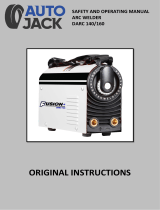20 GB
EU Declaration of Conformity / Warranty and service information
and the amendments to these Directives.
The object of the declaration described
above meets the requirements of
Directive 2011/65/EU of the European
Parliament and of the Council of 8June
2011 on the restriction of the use of
certain hazardous substances in
electrical and electronic equipment.
This conformity assessment is based on
the following harmonised standards:
EN 60974-1:2018/A1:2019
EN 60974-10:2014/A1:2015
St. Ingbert, 22/10/2020
pp Dr Christian Weyler
– Quality Assurance –
zWarranty and service
information
Warranty from Creative
Marketing & Consulting GmbH
Dear Customer,
The warranty for this equipment is
3years from the date of purchase. In the
event of product defects, you have legal
rights against the retailer of this product.
Your statutory rights are not affected in
any way by our warranty conditions,
which are described below.
zWarranty conditions
The warranty period begins on the date
of purchase. Please retain the original
sales receipt. This document is required
as your proof of purchase.
Should this product show any defect
in materials or manufacture within
3years from the date of purchase, we
will repair or replace it – at our dis-
cretion – free of charge. This warranty
service requires that you retain proof of
purchase (sales receipt) for the defective
device for the three year period and that
you briefly explain in writing what the
fault entails and when it occurred.
If the defect is covered by our warranty,
we will repair and return your product
or send you a replacement. The original
warranty period is not extended when a
device is repair or replaced.
zWarranty period and
statutory claims for
defects
The warranty period is not extended
by the guarantee. This also applies to
replaced and repaired parts. Any dam-
ages or defects detected at the time of
purchase must be reported immediately
after unpacking. Any incidental repairs
after the warranty period are subject to
a fee.
zExtent of warranty
This device has been manufactured
according to strict quality guidelines and
carefully inspected before delivery.
The warranty applies to material
and manufacturing defects only. This
warranty does not extend to product
parts, which are subject to normal wear
and tear and can thus be regarded as
consumable parts, or for damages to
fragile parts, e.g. switches, rechargea-
ble batteries or parts made
from glass.
This warranty is voided if the product
becomes damaged or is improperly
used or maintained. For proper use






















